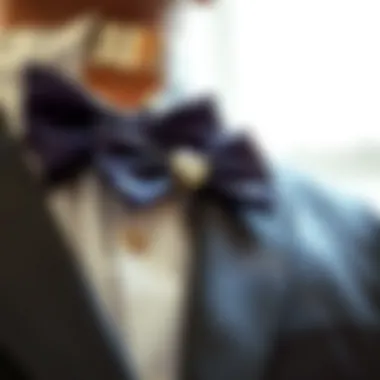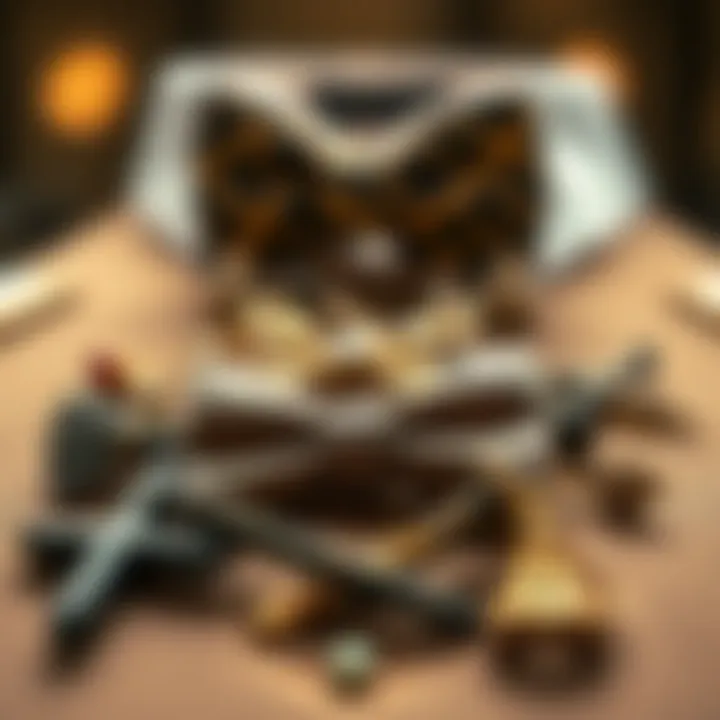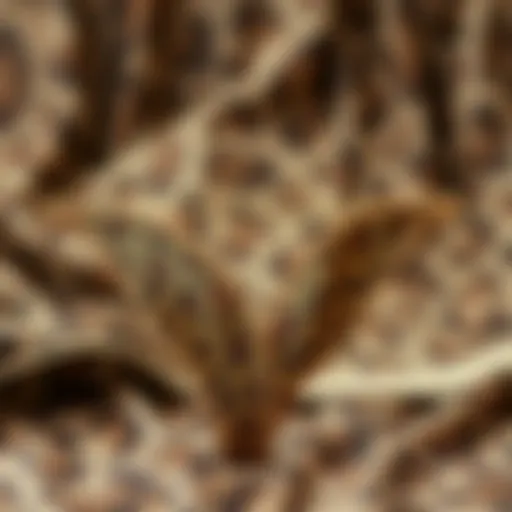The Bow Tie Lapel Pin: Elevate Your Style with Ease


Intro
The bow tie lapel pin is more than just a decorative flourish; it’s a subtle nod to tradition and a bold statement of personal style. Often overlooked in the grand tapestry of men’s fashion, this accessory can serve to distinguish an individual's taste. In a world where first impressions are often made in a flash, the bow tie lapel pin signifies attention to detail and a flair for elegance.
In this guide, we will take a close look at the history, symbolism, and current trends surrounding the bow tie lapel pin. We will explore how this classic piece can fit seamlessly into both formal and semi-formal attire, making it an essential accessory for modern wardrobes. By diving into the various materials and styles available and providing practical advice on selection and care, our aim is to empower you to master the art of incorporating the bow tie lapel pin into your daily fashion choices.
Let's first examine current fashion trends to understand how this pin has carved out its niche in contemporary style.
Fashion Trends
Current Seasonal Trends
Fashion, like the seasons, is ever-evolving. The bow tie lapel pin has made a significant resurgence, particularly in formal settings, where meticulous attention to detail is expected. In recent years, designers have embraced a plethora of colors and materials, transforming traditional designs into statements of individuality. Bright hues and unique patterns are trending, allowing wearers to express their creativity while still adhering to the sophisticated aura that the lapel pin exudes.
Some key trends to watch for this season include:
- Sustainable Materials: Eco-friendly fabrics are taking center stage, with many designers opting for recycled materials and ethically-sourced fabrics.
- Minimalist Designs: Simple, elegant pins in classic shapes are enduringly popular. These pieces often feature clean lines and are crafted from metals such as silver or gold.
- Vintage Revival: Bow tie pins inspired by vintage designs are making a comeback, as nostalgia plays a major role in modern fashion.
Influential Fashion Icons
Fashion icons of our time have certainly contributed to the reimagining of the bow tie lapel pin. Their daring choices and stylish ensembles not only set trends but also influence the staples in men's wardrobes. Figures such as Ryan Gosling and David Beckham are regularly seen adorning themselves with lapel pins, each selection speaking volumes about their stylistic inclinations.
Here are a few contemporary influencers who have popularized the bow tie lapel pin:
- Ethan Wong, whose use of bold prints and colors has revived interest in this classic accessory.
- Benedict Cumberbatch, who tends to favor more traditional styles, elevating the pin's status in formal settings.
- Jared Leto, known for his eclectic fashion sense, often incorporates unique lapel pins that tell a story.
With these trends and icons in mind, let’s move on to practical styling tips that ensure the lapel pin is not just an accessory, but a defining element of any outfit.
Styling Tips
Outfits for Different Occasions
When it comes to outfits, the bow tie lapel pin can add a touch of elegance, whether for a wedding, formal meeting, or a casual get-together. Choosing the right outfit is essential to ensure the pin complements rather than overshadows. Here’s how you might approach various occasions:
- Wedding: A navy suit paired with a cream-colored shirt and a floral bow tie lapel pin can create a charming look.
- Corporate Meeting: Opt for a gray suit and a simple silver lapel pin to convey professionalism without losing style.
- Casual Gatherings: Combine a blazer with a casual shirt, finishing the look with a quirky or colorful lapel pin.
Mix and Match Techniques
Mixing and matching is an art. The bow tie lapel pin provides a fantastic opportunity to play with colors and patterns. Here are several tips to acheive the perfect blend:
- Color Coordination: Ensure your lapel pin complements your outfit. For example, a patterned pin can work well with a solid-colored suit.
- Layering: If wearing a more complex pattern, like plaid, balance it out with a solid-coloured lapel pin.
- Texture Play: Utilize different materials, like a textured dress shirt paired with a smoother pin, to enhance visual interest.
Ultimately, the bow tie lapel pin is a versatile accessory that can speak volumes of personal style and flair. By understanding current fashion trends and employing clever styling techniques, you can seamlessly integrate this accessory into your wardrobe and elevate any look.
In fashion, it’s the small details that can make the most significant impact. Choose your lapel pin with intent and let it reflect your unique style.
For further reading on the history of fashion accessories, you may find these resources insightful:
These readings will expand your knowledge about the intricate world of fashion and how the bow tie lapel pin has carved its niche within it.
Understanding the Bow Tie Lapel Pin
A bow tie lapel pin is an accessory that does more than just adorn a jacket. In a world where personal style often gets overshadowed by trends, this pin stands as a beacon of individuality and timeless elegance. Understanding this ornament requires delving into its definition and purpose, as well as recognizing the rich cultural significance it carries across various contexts.
Definition and Purpose
The bow tie lapel pin is essentially a small piece of jewelry designed to be worn on the lapel of a jacket, contrasting beautifully with the fabric. Unlike its larger counterpart, the traditional bow tie, the lapel pin is subtle, offering just a hint of flair that can elevate an outfit from ordinary to extraordinary.
Typically made from materials such as metal, fabric, or even wood, these pins come in various designs and styles, reflecting the wearer’s personality and preferences. The main purpose of a lapel pin is not just to be seen, but to convey a message—a slice of one's identity that can signify everything from a sense of humor to socio-political affiliations.
For designers and stylists, this accessory presents a unique opportunity to incorporate elements of storytelling into formal attire. It serves as a conversation starter in gatherings, displaying not just style choices, but also the wearer’s aesthetic philosophy.
Cultural Significance
Culturally, the bow tie lapel pin embodies a blend of tradition and modernity. This accessory has its roots in formal attire across various cultures, often associated with celebration and status. In many countries, wearing a lapel pin can signify allegiance or commemorate special occasions. For example, during weddings, it's common to see groomsmen sporting these pins, adding a dash of elegance to their attire.
Furthermore, the bow tie lapel pin has been embraced by fashion icons and influencers, contributing to its eclectic cultural representation. It’s not just a piece of fabric or metal stitched onto a suit; it tells a story that is both personal and universally relatable.


"The difference between ordinary and extraordinary is that little extra."
- Jimmy Johnson
This saying captures the essence of the bow tie lapel pin perfectly. The choice to wear it reflects a desire to stand out, to be seen as someone who pays attention to details, and understands the art of refinement in dress.
In summary, understanding the bow tie lapel pin is integral to anyone interested in fashion. It is a multifaceted accessory that holds both aesthetic and emotional significance, transforming simple attire into a statement of elegance and individuality.
Historical Context of the Bow Tie
Understanding the historical context of the bow tie is pivotal for comprehending its role in modern fashion. This accessory isn’t just a fleeting trend; it carries with it a rich tapestry of traditions and evolutions that speak volumes about social status, craftsmanship, and cultural movements. By exploring its origins and transformation, one can appreciate how the bow tie lapel pin has become a distinguishing feature in today’s wardrobes, marrying elegance with personal expression.
Origins of the Bow Tie
The bow tie, as a formal accessory, traces its roots back to the 17th century. Originating among Croatian mercenaries, these ties were simple pieces of fabric used to hold together the flaps of their shirts. Soon after, embraced by French aristocrats, this functional item morphed into a symbol of sophistication. The term "cravat" became synonymous with these early ties, derived from the French word for Croat. Its initial appeal rested on its novelty and the air of aristocracy it brought to the wearer.
As time progressed, these early designs paved the path for the bow tie as we know it. By the 19th century, the bow tie had solidified its presence in men’s fashion, particularly during the Victorian era. At this juncture, it was often associated with the upper class, thus enhancing its status as an emblem of elegance. During this era, several styles began to emerge, setting the groundwork for widespread adoption across various demographics, bridging class gaps in style.
Evolution through the Decades
The 20th century brought significant changes to the bow tie’s place in fashion. Initially prominent among formal wear, it faced varied fates across the decades.
- 1920s-1930s: The bow tie experienced a renaissance with the rise of jazz and the dapper gentleman ideal, becoming a staple of suave attire in evening wear. It was during this time that the infamous "Hollywood Bow Tie" became popular, often seen on leading men in classic films.
- 1940s-1950s: This era marked a transitional phase. With the post-war cultural shifts, the bow tie began to appear in less formal settings, adopted by intellectuals and creatives, including writers and artists, giving it a somewhat avant-garde image. However, it still retained its formal roots in black-tie events.
- 1960s-1970s: The counter-culture movements led to a playful reimagining of sartorial norms. The bow tie fell into a niche category, viewed as quirky or eccentric, largely influenced by figures such as Doctor Who, creating an association with intellectual wit.
- 1980s-Present: Fast forward to today, the bow tie has made a dazzling comeback, especially within fashion circles that embrace retro aesthetics. Designers are now experimenting with a plethora of fabrics, colors, and styles, and it’s not uncommon to see it juxtaposed with casual wear.
In this layered history, we see that the bow tie lapel pin is not merely an accessory; it is a reflection of societal change and individual identity. Each phase of its development has crafted a narrative, influencing its significance in contemporary fashion.
"The bow tie is more than just a knot; it's a statement of style that echoes the past while making waves in the present."
By delving into where it came from, we can truly understand its current position and perhaps predict where it might go next.
The Aesthetic Appeal of a Lapel Pin
The aesthetic appeal of a lapel pin, especially the bow tie variation, plays a pivotal role in defining one’s style statement. While garments, shoes, and accessories all contribute to an overall look, it’s often the details that make the biggest impact. A bow tie lapel pin not only serves as a nod to tradition but also adds depth and character to an ensemble. It bridges the gap between understated elegance and personal expression, making it a necessary accessory for anyone wishing to leave a lasting impression. This section delves into the various design variations of lapel pins as well as examining the often overlooked yet crucial influence of color in fashion.
Design Variations
Traditional Bow Tie Designs
Traditional bow tie designs present a timeless aesthetic that embodies the essence of classic menswear. These designs are characterized by their symmetrical shape, typically featuring a knot tied centrally. This structure not only lends an air of formality, but also functions as a conversation starter, especially among aficionados of sartorial detail. The traditional bows can be made from silk or cotton, allowing for a plush texture and refined shine that enhances their visual appeal.
One singular advantage of traditional designs is their versatility; they can be seamlessly integrated into both formal attire like tuxedos or semi-formal settings such as tailored suits. However, potential downsides could include the lack of boldness when compared to more contemporary interpretations, which embrace daring colors and textures. Yet, for those who appreciate the finer points of classic fashion, traditional designs remain a popular and beneficial choice.
Modern Interpretations
Modern interpretations of the bow tie lapel pin represent a break from convention, infusing creativity and individuality into this accessory. These designs might employ asymmetrical shapes, unconventional materials, or even whimsical prints. The key characteristic of modern interpretations is their ability to reflect personal style while maintaining a nod towards tradition. A lapel pin that features a quirky design can take a standard business suit from mundane to memorable without skipping a beat.
While the broader appeal of these modern designs attracts a youthful demographic seeking uniqueness, there can be a risk of overshadowing the quality of the overall outfit. Not every modern design complements every setting; hence the awareness of context in which they are worn is essential. Still, the allure of standing out makes these interpretations an increasingly popular choice for those eager to express their uniqueness.
Customizable Options
Customizable options for lapel pins offer the ultimate expression of personal flair. This flexibility allows one to tailor the accessory to their own taste, whether by selecting colors, materials, or even thematic designs. Driven by the desire for individuality, many choose to create pins that reflect their hobbies, interests, or significant life moments.
A standout feature of customizable lapel pins is their gift potential. Presenting a personalized pin conveys thoughtfulness and consideration, making it an excellent choice for occasions like weddings or graduations. However, while the customization can enhance personal meaning, it might not always align with universal fashion norms, potentially leading to mismatch in more formal settings. Ultimately, the ability to design a pin that resonates on a personal level adds a layer of connectivity and significance, ensuring it’s a treasured part of one’s wardrobe.
Color Psychology
Color psychology is another crucial element worth considering when discussing the aesthetic appeal of a lapel pin. Different colors evoke varying emotions and symbolize unique messages. For instance, a navy blue lapel pin connotes trust and dependability, making it suitable for professional environments. In contrast, a vibrant red can signify confidence and enthusiasm, especially appealing in social situations.
When selecting a color for a lapel pin, consider the entire outfit and the context of the event. The right combination can elevate an outfit to new heights. Thus, understanding the subtle language of colors not only adds visual intrigue but also reflects the wearer’s intention and character.
Choosing the Right Lapel Pin
Selecting the right lapel pin is pivotal in ensuring that your choice not only complements your outfit but also aligns with your personal style. It’s about more than just aesthetics; it encompasses a deeper understanding of how this accessory operates within different contexts. The artistry of a well-chosen pin can elevate your look from mere functionality to a nuanced expression of taste.
Matching with Attire
Color Coordination
Color coordination is an intrinsic aspect that can make or break your overall appearance. It’s not just about matching colors; it’s about creating a harmony between the pin and the attire you are wearing.
When you think about color coordination, consider the wheel of colors. A keen eye for color relationships can turn a simple outfit into a statement. For example, a navy suit paired with a burgundy lapel pin introduces a striking contrast that demands attention, yet remains classy. This choice isn’t merely popular; it shows a mastery of subtlety in fashion. It’s a prime example of how well-balanced accents can elevate one's look without overshadowing the outfit itself.


One unique feature of color coordination lies in its versatility. You can choose colors that complement, contrast, or even harmonize with your outfit. The advantages? A buttoned-up look can feel approachable and not overly stiff, facilitating conversations and interactions.
Formal vs. Semi-Formal Settings
Understanding the distinction between formal and semi-formal settings is crucial in choosing your lapel pin. Each environment lends itself to different expectations regarding style. In formal settings like weddings or gala dinners, a traditional, understated pin might convey respect and seriousness. This simplicity can be a benchmark for elegance.
On the other hand, semi-formal events, such as brunches or relaxed parties, allow for a bit more freedom in expression. Here, you might opt for a playful, colorful pin that showcases your personality without straying into the realm of informality. The choice of a pin in these settings does not merely serve as decoration; it becomes an extension of yourself.
This knowledge offers a significant advantage as it bridges the gap between personal expression and situational appropriateness, allowing you to navigate various social landscapes gracefully.
Material Considerations
Metal Options
Diving into the material of lapel pins, metal options tend to dominate the market. The gleam of polished brass, silver, or even gold can render your accessory unexpectedly striking. Each type of metal also carries its unique weight and texture which, in turn, can affect the feel of your whole ensemble.
For instance, a silver pin often feels sleek and modern, while a brass option may impart a vintage charm to an outfit. Knowing what suits you can be an asset in refining your look. However, with metal comes a consideration of durability. Some metals are prone to tarnishing, which means extra care is needed to keep them looking sharp.
Fabric Lapel Pins
Contrastingly, fabric lapel pins offer a different tactile experience. Made from textiles, these pins come in a variety of colors and patterns, providing a striking juxtaposition against stiff materials. A fabric pin can seamlessly meld into a laid-back look, enhancing casual attire without trying too hard.
These pins often have a unique feature in their ability to add depth. With the right selection, they can transform a simple jacket into a multidimensional outfit. The downside? Fabric pins may not hold up in more formal settings, where the expectation leans towards classic metal designs.
Sustainable Materials
With the rise in conscious consumerism, sustainable materials are gaining traction in fashion. Accessorizing with eco-friendly lapel pins not only showcases style but also aligns with values of responsibility. These can include materials like recycled metals, or organic fabrics, which contribute to a positive environmental impact.
The unique feature of sustainable pins is that they tell a story—they often resonate with like-minded individuals who prioritize ethical fashion. However, one must consider the accessibility and cost, as sustainable options can sometimes come at a premium.
In summary, the right lapel pin isn’t merely a decorative element; it can serve as a conversation starter, a reflection of personal style, and an ethical choice, all rolled into one. Equipping oneself with knowledge about matching attire, materials, and context can transform styling choices into thoughtful decisions.
Integrating the Lapel Pin into Your Wardrobe
Integrating a lapel pin into one’s wardrobe is no small feat. It serves not only as an ornament but as a statement piece, capable of elevating an ensemble from ordinary to extraordinary. A bow tie lapel pin, while subtle, carries the weight of tradition and finesse, making it an ideal companion for various occasions. The right lapel pin can demonstrate individual flair, signal sophistication, and even pay homage to personal identity or affiliations.
When it comes to incorporating this accessory into your daily attire, considerations abound. Style is paramount; choosing a design that resonates with your outfit is crucial for coherence. Understanding Context is another vital element; the appropriateness of a lapel pin can vary dramatically between formal events, professional settings, or casual outings. Ultimately, the benefits of integrating a bow tie lapel pin extend beyond mere aesthetics; it enhances your overall image and allows for creative expression within the bounds of fashion.
Styling Tips for Events
Weddings and Formal Gatherings
In the context of weddings and formal gatherings, a bow tie lapel pin becomes not just an accessory but a part of the overall celebration. Often, such events emphasize elegance and meticulous attention to detail, making the lapel pin a fitting addition. It serves to complement the tuxedo or tailored suit, providing a touch of individuality in the sea of classic attire.
Key Characteristic: The unity it brings to an outfit. The wedding ensemble can be very harmonious when adorned with complementary accessories. Incorporating a lapel pin that reflects the wedding color palette or theme assists in not only showcasing personal style but also honoring the occasion itself.
Unique Feature: In many cultures, a specific emblem or motif on lapel pins can signify honor and connection. Its inclusion feels especially poignant amidst the emotional tapestry of weddings.
Corporate Events
When attending corporate events, a well-chosen lapel pin can be an excellent means of professional embellishment. It serves to balance professionalism with personal style rather than veering towards monotony. In business contexts, the lapel pin can establish authority and align with one's brand.
Key Characteristic: The subtlety it provides. In a sea of suits, a lapel pin can act as a conversation starter, providing a sense of approachability while still ensuring professionalism.
Unique Feature: The corporate world often has unwritten dress codes; thus, using a more traditional or understated design can portray reliability and competence.
Casual Outings
Amid casual outings, a lapel pin may seem out of place, but on the contrary, it allows for an exploration of style without grave repercussions. It presents an opportunity to showcase creativity and personality in a relaxed manner, often being an unexpected surprise that enhances a simple outfit.
Key Characteristic: The versatility it offers. Pairing a lapel pin with a shirt and jeans may inject a bit of flair into an otherwise laid-back look.
Unique Feature: Casual outings are about relaxation, and adding a quirky or playful lapel pin can reflect an individual’s sense of humor or interests, making you more relatable and approachable.
Layering with Other Accessories
Layering a lapel pin with other accessories is an art that requires a bit of finesse. It entails harmonizing various elements without overwhelming one's appearance. Consideration must be given to ties, pocket squares, and even wristwatches. For instance, if a pocket square is worn, ensure that both accessories complement each other in either color or pattern. Utilizing a minimalist tie alongside a bold lapel pin can create visual intrigue without feeling cluttered.
Adding a watch to this ensemble would also signify attention to detail while maintaining synergy among accessories.
"Fashion is all about expressing who you are without having to speak."
Decorating yourself with a bow tie lapel pin embodies this ethos—it's silent yet powerful.
Care and Maintenance of Lapel Pins


Caring for a lapel pin is not merely a chore; it’s an art. The right maintenance can ensure the longevity of this small yet significant accessory. Given that lapel pins are often crafted from delicate materials or intricate designs, understanding how to clean and store them properly can make a world of difference. Neglecting this aspect not only risks damaging the pin but also diminishes its aesthetic value and the statement it makes when worn. Therefore, developing a solid routine for the care and maintenance of lapel pins is essential for anyone keen on preserving their fashion elegance.
Cleaning and Storage
Cleaning your lapel pin thoroughly is the first step to maintaining its sheen and integrity. Dust and grime can accumulate over time, dulling its finish and making it appear lackluster. Here are a few practical tips to keep your lapel pin looking as sharp as the day you got it:
- Gentle Wipe: Use a soft cloth to gently wipe off any light dirt or fingerprints. Microfiber cloths are particularly effective.
- Cleaning Solution: For more stubborn stains, a mild soap mixed with water can do wonders. Just make sure to rinse it thoroughly afterwards to avoid any residue.
- Drying: Never store it while still wet, as moisture can lead to tarnishing. Let it air dry completely.
When it comes to storage, consider investing in a protective case or a jewelry box lined with a soft fabric. This can prevent scratches or dents that might occur if the pin comes into contact with other accessories. A dedicated area for lapel pins helps you find your favorites quickly, without rummaging through a messy pile of clothes or other items.
Avoiding Damage
Preventing damage to your lapel pin is just as important as cleaning it. Here are some considerations:
- Avoid Heavy Outfits: When wearing a lapel pin, it’s best not to wear heavy outer layers that might snag on the pin. This is especially crucial during colder months when you might be tempted to layer excessively.
- Storage Away from Sunlight: Ultraviolet rays can fade the colors over time, particularly if your pin includes painted elements. Store your pins in a cool, dark place.
- Handle with Care: When attaching or removing your pin, do so gently. Avoid twisting or pulling too hard as this might bend the pin back or damage its clasp.
Maintaining a lapel pin should feel like a rewarding practice, not a drag. Little efforts in cleaning and mindful storage can extend the life of these adornments, allowing them to continue to elevate your style well into the future. Whether attending a high-profile event or a casual gathering, a well-cared-for lapel pin signifies attention to detail, finishing your look with an effortless touch of elegance.
"A lapel pin is more than an accessory; it's a reflection of personal style and an investment in one’s appearance."
By adopting a thorough cleaning regimen and protecting your lapel pins, you can ensure these small emblems of taste stay pristine and effective in their stylistic role.
Current Trends in Bow Tie Lapel Pins
In the ever-evolving world of fashion, lapel pins—especially those styled to resemble bow ties—are making quite a stir. While their roots lie deep in tradition, contemporary trends have brought new life and innovation to this distinguished accessory. Acknowledging current trends in bow tie lapel pins is key to understanding how these pieces can enhance personal style in today’s wardrobe. Whether for personal expression or professional attire, the relevance of these pins extends beyond mere decoration.
Influence of Fashion Icons
Fashion icons hold a significant sway in what styles find favor among the masses. Celebrities and influencers have taken to wearing bow tie lapel pins in various contexts, showcasing their versatility and elegance. For example, take a notable figure such as David Beckham, who is often seen sporting pins that echo traditional designs with a twist—vibrant patterns or unique materials. This not only elevates the overall ensemble but also signals a return to classic influences with a modern edge.
The embrace of this accessory by such high-profile figures helps to carve out its space in formal and casual arenas alike. When icons make bold choices, followers often feel encouraged to adopt similar styles, thus reinforcing the lapel pin’s status as a must-have. It's not just about wearing a piece; it's about making a statement. As these fashion leaders adapt their styles, they breathe fresh air into the bow tie lapel pin, encouraging others to explore different interpretations of sophisticated dressing.
Social Media Impact
In today’s digital age, social media serves as a powerful tool for setting trends and influencing fashion choices. Platforms like Instagram and Pinterest are brimming with images of well-dressed individuals showcasing their unique styles, lapel pins included. The hashtags like #BowTiePins or #AccessoryGoals generate a wealth of inspiration and allow everyone to see how this accessory can be integrated into various outfits.
Moreover, the power of influencers cannot be understated. Through their blogs and posts, they set forth styling tips that emphasize the bow tie lapel pin's adaptability—how it can complement everything from tailored suits to casual jackets. The visual nature of these platforms means that looks can be shared and dissected at lightning speed, propelling trends faster than ever.
"In a world where fashion trends change with the wind, the bow tie lapel pin's ability to adapt and endure speaks volumes about its design and significance."
Sustainable Practices in Accessory Fashion
As the world grows increasingly aware of environmental issues, the fashion industry faces its own reckoning. When it comes to accessories like the bow tie lapel pin, sustainable practices are more important than ever. Not only do these practices help the environment, but they also resonate with consumers who value ethical choices. By focusing on how accessories can be produced responsibly, we can blend style with sustainability.
The concept of sustainable fashion emphasizes the importance of reducing waste, using eco-friendly materials, and supporting fair labor practices. Customers are making more conscious decisions, seeking products that reflect their values rather than just their tastes. This shift is essential in ensuring that fashion remains socially responsible while still being stylish.
Ethical Sourcing of Materials
Woven into the fabric of sustainable fashion is the notion of ethical sourcing. This term encompasses how materials are acquired and the overall impact those choices have on the environment and communities.
Using ethically sourced materials not only minimizes pollution and deforestation but also ensures that artisans are paid fairly for their work. For example, organic cotton or recycled metal can reduce the carbon footprint, offering a more sustainable alternative to traditional materials. Moreover, brands that are open about their sourcing policies tend to foster consumer trust. Transparency regarding the journey of materials from concept to creation allows buyers to feel satisfied that they’re making a responsible choice.
"Choosing sustainably sourced materials for accessories is not just a trend; it's a necessary movement that underpins modern fashion."
Supporting Local Artisans
An often-overlooked aspect of sustainability within accessory fashion is the importance of supporting local artisans. By purchasing bow tie lapel pins handmade by local craftspeople, consumers can help keep traditions alive while boosting local economies.
Artisan-made products often come with unique stories and craftsmanship that mass-produced items lack. This authenticity can be a significant selling point for consumers who desire individuality in their accessories. By investing in local talent, they contribute to a sustainable ecosystem that nurtures creativity, skill, and heritage. Additionally, supporting local artisans helps reduce the carbon footprint linked to long-distance shipping.
In the end, merging style with sustainability does more than embellish an outfit. It's a statement that resonates with a consumer base eager to wear their values on their sleeves— or lapels, in the case of the bow tie lapel pin. As the accessory world evolves, it’s crucial to remember that elegance can be achieved responsibly, one thoughtful choice at a time.
Epilogue
The bow tie lapel pin serves as more than just an accessory; it is a symbol of sartorial elegance that has managed to withstand the test of time. In this article, we’ve explored the multifaceted role that the bow tie lapel pin plays in the realm of fashion, from its historical roots to its contemporary relevance.
The Timeless Nature of the Bow Tie Lapel Pin
The essence of the bow tie lapel pin lies in its versatility. It can be the crowning touch for a formal tuxedo, or it can effortlessly elevate a business-casual ensemble. This flexibility makes it a beloved choice among fashion designers, stylists, and individuals looking to express their unique personality.
In a world that often clings to fleeting trends, the bow tie lapel pin stands as a steadfast reminder of the importance of detail in fashion. Whether adorned with a simple yet elegant design or featuring bold colors and intricate patterns, these pins offer a chance to showcase one's individuality without overwhelming an outfit. This balance between subtleness and statement allows it to resonate with various audiences, from corporate settings to social events.
"In fashion, it’s the details that speak volumes, and a bow tie lapel pin whispers sophistication."
As we venture into an era where personalization is highly valued, the bow tie lapel pin affords an opportunity to reflect one’s personal style and values. Choosing ethical materials or supporting local artisans can add an extra layer of meaning to this simple accessory, making it not just a cosmetic addition but a part of one’s wardrobe narrative.
Ultimately, the bow tie lapel pin embodies a fusion of tradition and modernity, holding significance in various cultures while allowing for personal expression. Its resilience and adaptable nature assure its place in wardrobes for generations to come.















